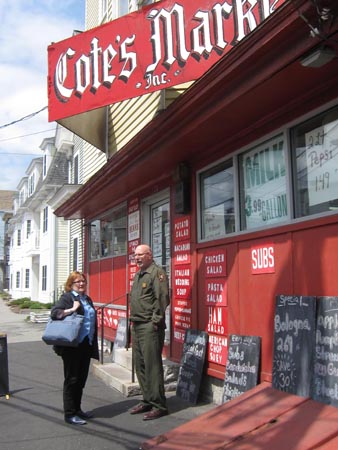Lowell ‘Foodways’ Highlighted in Globe

Photo courtesy of Maggie Holtzberg from blog.massfolkarts.org. See also Keepers of Tradition on the blogroll to the right.
Nine, count ’em, nine color photos of details from Lowell’s multi-ethnic market scene grace page one of the Globe North section of today’s Boston Sunday Globe. The article by Taryn Plumb recounts a recent bus tour of ethnic markets organized by folklorist Maggie Holtzberg of Lowell National Historical Park. The well-attended bus tour and resulting publicity illustrate just how big a draw the city’s multi-cultural cuisine is. An authentic resource, these businesses are a key to deriving as much value as possible from the creative economy slice of the region’s economic pie. We can’t buy this kind of positive publicity with the money in the City’s marketing budget. Presented to the public in innovative ways, aspects of Lowell sell themselves to the media—which is a big plus.
At Cote’s Market the other day, I picked up a pint of beans, stuffed peppers, Chinese Pie, and a square of salmon puffed pastry that was warm from the oven. Owner Roger Levasseur said the tour and related buzz led to an immediate boost in activity at the long-standing Salem Street store that offers Franco-American specialities and a wide array of ready-to-heat comfort foods. “A couple of days later my big refrigerated case of prepared foods was practically wiped out by mid-afternoon,” he said. “All kinds of people had heard about us. It was great.”
Kudos to the small-business owners who keep these traditions alive, and kudos to Maggie Holtzberg and David Blackburn of the Park Service for their creative approach to designing public programs. Here’s an example of the challenge Lowell seeks to achieve in its presentation of cultural experiences. How can the experience had by the 35 people on the bus be offered to larger numbers of people without disrupting the operations of small distinctive businesses that are clearly an attraction? Residents can easily enough buy in the stores once they know about them. For visitors, do we point to these special places and encourage people to discover them on their own or should there be regular tours enhanced by the knowledge of folklorists and Park Rangers? How do you “organize” the experience and keep it genuine—steering clear of a packaged “theme park” feeling? This is what’s different about managing a National Park in the middle of a living city. The Park Service on this tour showed how it is done.
Now I’m REALLY hungry.
Me too, I guess I’ll have to wait until tomorrow though!